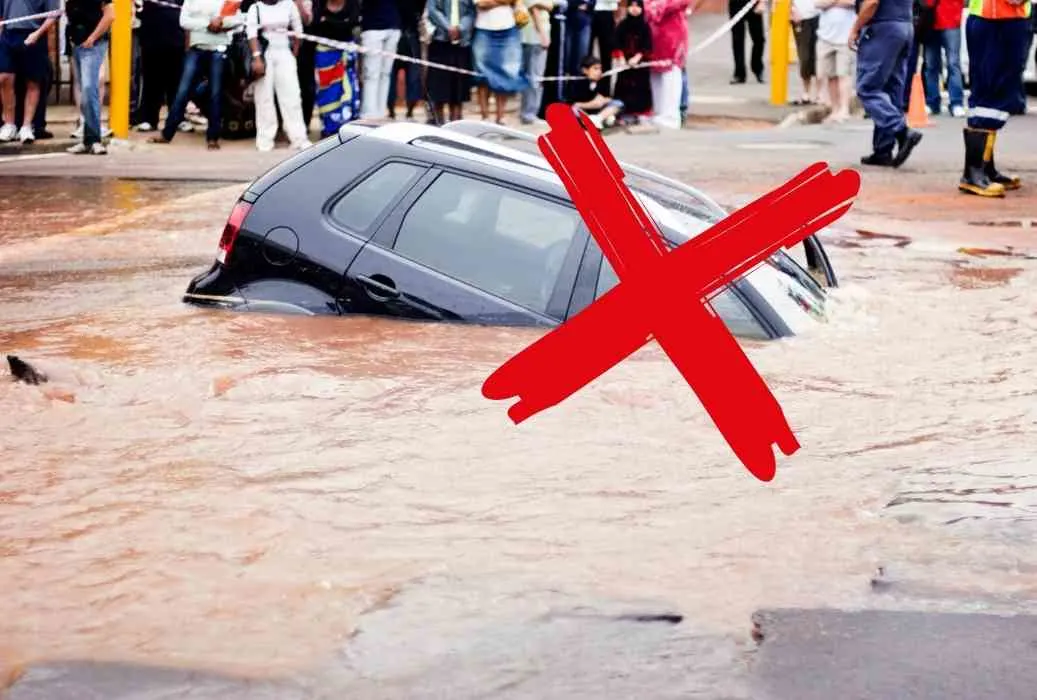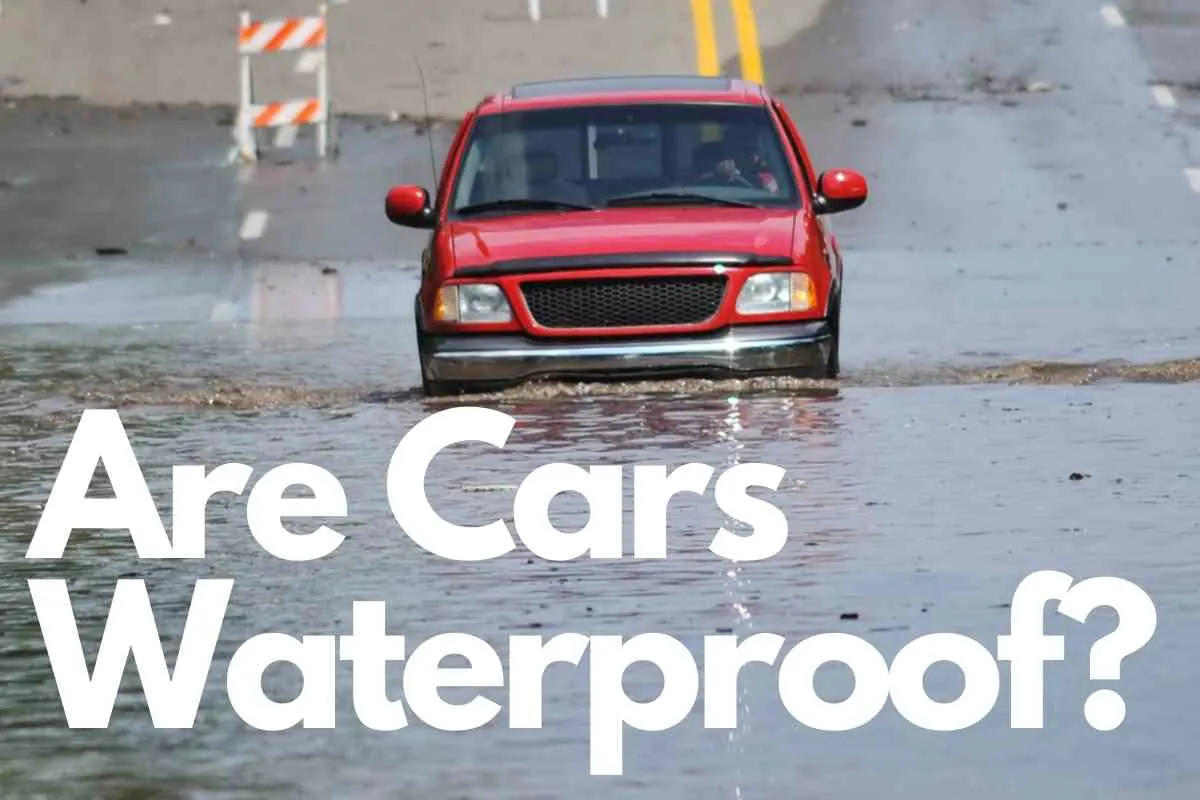Between movies and our own anxieties, we’ve probably all pictured ourselves careening off a bridge or stuck in a flood inside of our vehicles as the cab begins to slowly fill with water.
It’s an unlikely scenario but one that does happen frequently enough that well-prepared drivers need to equip themselves with the right knowledge and tools to save themselves if they find themselves underwater in their vehicle.
One of the first and most important factors is what happens to your car when it’s submerged in water. Are cars waterproof?
Cars are not waterproof. They do have some leak-proof fillings around the doors and windows to prevent rain and other moisture from entering the vehicle’s vital components, but water can still get into both the engine and the interior if the vehicle is submerged in water.
Attempting to drive through water might be disastrous to your vehicle and can be dangerous to you as well.
If a car was truly airtight, the vehicle would float in water instead of sinking as it usually does!
In water, liquid typically gets into the cabin through the ventilation system of the vehicle. It takes a few minutes for the vehicle to completely fill up with water.
The car takes a minute or two to sink because liquid similar in volume has to be displaced for it to be fully submerged.
It’s impossible to open either the windows or the door underwater because of the differences in water pressure.
However, once the cabin completely fills up with water, the pressure inside and outside the vehicle are the same and the door will open.
To prevent the difference in air pressure, rolling down the windows before the car is covered by water is the best option.
Let’s take a look at what happens to your vehicle when you decide to drive in water.
Can a Car Engine Run Underwater?

If the water gets above the engine’s air intake while it’s still running, the vehicle will suck in the water.
This would cause the engine to hydrostatic lock i.e.; the water will get into the engine cylinders.
This potentially freezes the engine’s pistons and causes the engine to stall.
As a result, the water would cause severe damage to the engine because water doesn’t compress like air.
Because the water has no place to escape through, the compression problem will cause the piston rods to start bending and the tension will cause them to break eventually.
When the piston rods break, they will cause a chunk of the engine to break. This will either be at the top or the bottom of the engine.
This damage would most likely require an engine rebuild or total replacement.
However, if water gets into the engine when it’s off or stalled, the engine will require water to be removed before starting the engine to avoid the occurrence of a hydrostatic lock.
Rust is also a major problem when water gets into the engine and other parts such as the differential.
Therefore, you shouldn’t try to start the vehicle while underwater to avoid ruining the engine.
How Much Water Can a Car Safely Handle?
There is no specific answer here because it will depend on the vehicle.
As long as the air intake of the vehicle remains above water, the engine will probably be fine.
If not, ensure that the engine is not on so that water isn’t sucked into the engine.
Ways to Increase a Vehicle’s Water Capabilities
Most cars aren’t designed to operate underwater.
However, there are a number of things that you could do if you want to drive in the water.
Here are a few options to consider:
For a vehicle to run, it should have an air source and a way for the vehicle to release its exhaust gases. Depending on the depth of the water, the exhaust gases will escape due to the pressure.
To solve the air intake problem, you might add a snorkel to the equation.
Most military Humvees already have a snorkel that is connected to a port on the passenger side of the vehicle on the hood.
This snorkel will allow the vehicle to go up to a depth of 5 feet and still get steady air intake.
Once these two problems have been addressed, the vehicle can run underwater.
Although the engine has been waterproofed, there are still some issues you might want to think about such as:
- The fuel tank should be correctly vented and sealed to prevent water from mixing with the fuel
- All electrical devices such as engine control computers, lights, instruments, motors that control the windshield wipers or fans and the battery must be sealed to avoid damage
- Items such as the differential and crankcase must either be sealed or vented as high as the snorkel
- Ensure that any crevice or chamber that water can get in through has a drain.
It is, however, important to note that a gasoline engine is harder to waterproof because of its spark plugs and ignition compared to a diesel engine.
They run on very high voltages and sealing them is complicated.
In cases where the diesel engine runs its injectors on a mechanical fuel pump and a mechanical transmission, sealing is easier.
This is because there are no engine control electronics that can get damaged.
What to Check After Driving in Water?
After driving through water, you might want to check:
1. The brakes
Wet brakes will often lose their grip.
While the car is still on, press the brakes a few times so that they can dry out.
2. The Engine
You should listen to the sounds coming from your engine as they will tell you whether or not water has affected the engine.
Unusual sound or behavior from the engine means that there is a problem and you should take the vehicle to an auto repair shop immediately or have it towed if it has stalled.
3. The electronics
Any water damage will fry the vehicle’s entire electrical system.
Although it’s unlikely because of the waterproof electrical connection and a protected fuse box, it’s better to be safe and check.
Cars Driving In Water
Although cars aren’t waterproof as previously discussed, it’s important for you to take care of your engine.
Some vehicles are constructed with off-road capabilities but the majority of vehicles should not be driven in water.
In case you live in a flood zone, ensure that your vehicle isn’t turned on when it’s submerged in water.
The suction of air into the vehicle will ruin your engine and cost you an arm and leg in repairs.
Even if you feel your vehicle is fine after driving in water, get an expert to take a look just to be safe.
